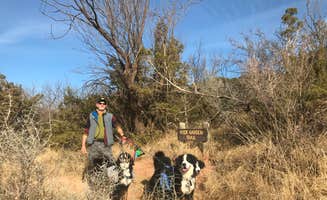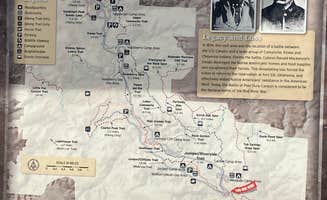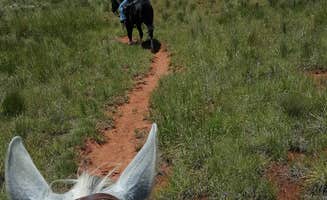The Equestrian Campground sits at the canyon floor of Palo Duro State Park, where colorful sandstone cliffs rise 600-800 feet from the prairie. Temperatures in this high plains environment can fluctuate dramatically, with summer daytime highs regularly exceeding 100°F and winter nights dipping below freezing. The canyon's unique microclimate supports juniper, cottonwood, and mesquite trees that provide natural shelter throughout the horse camping areas.
What to do
Trail riding in the canyon network: Access over 1,500 acres of riding trails directly from Plum Creek, where equestrians will find "miles upon miles of trails" with water for horses "courtesy of local Eagle Scouts" according to Phil & Jennifer K. The trails connect to broader networks throughout the park.
Explore wildlife viewing opportunities: Morning rides offer the best wildlife encounters. At Hackberry Campground, campers report "wildlife peaks out in the early mornings" and you can see "native wildlife like roadrunners, wild turkeys, and even deer," adding natural charm to rides.
Evening stargazing: Take advantage of minimal light pollution. Jackson M. notes Plum Creek offers "total silence" and "very peaceful" evenings, making it ideal for stargazing after a day of riding. During summer, plan evening activities after the intense daytime heat subsides.
What campers like
Secluded camping options: At Fortress Cliff Primitive, campers appreciate that "sites are spacious and shaded," though Rich J. notes it's "definitely one of the more primitive sites in the park" with porta-potties only. This provides a more authentic backcountry experience for horse campers.
Dedicated horse facilities: The corrals at horse campgrounds near Canyon, Texas receive positive reviews. Roger W. describes the Equestrian Campground as "a nice looking equestrian area with water available for horses" and notes the "nice corrals" available for overnight stays.
Canyon wall views: Many equestrian sites offer direct views of geological formations. Sonora J. describes camping with "awesome views of the canyon walls" and the experience of hearing "coyotes at night (eerie but also magical)!" The multicolored stratification of the canyon walls is visible from most horse camping areas.
What you should know
Terrain considerations: The 10% grade entrance road requires careful navigation with horse trailers. Jackie R. warns about "steep grade of 10% to enter the park itself" and notes that "long rigs could really have issues" with the "hairpin turns going in and out of the campground area."
Water availability: Natural water sources for horses can be unreliable, so bring extra. At Palo Duro Glamping, potable water is available, but most equestrian-specific sites require hauling water for horses during drier periods.
Limited facilities at some sites: Equestrian sites have varying amenity levels. Roger W. notes that at the Equestrian Campground, "I don't believe there are any restrooms here" and campers must go "down the road" for bathrooms and showers, making advance planning essential.
Tips for camping with families
Reserve well ahead: Horse camping sites fill quickly during peak seasons. Anna K. reminds visitors to "book in advance" as equestrian sites are limited and popular, especially during spring and fall when temperatures are moderate.
Consider multi-day stays: Allow time for multiple trail rides. John R. describes Palo Duro as a "wonderful huge park with an abundance of wildlife" offering not just "horseback riding" but also "hiking, bike trails, glamping and more" for family members who might not ride.
Weather preparation: Pack for temperature extremes that affect both horses and riders. Amy & Stu B. at Hackberry Campground note that "the park is STUNNING. Every hike is worth it. Every vista every viewpoint...incredible," but warn that water was "really chlorine-y" - important to consider for horses sensitive to water taste.
Tips from RVers
Site selection for horse trailers: Look for pull-through sites when possible. Roger W. advises that at the Equestrian Campground "large rigs can fit" and there are "pull throughs," though "campsites do not seem that well defined."
Generator policies: Verify which campgrounds permit generators for overnight horse monitoring. Jackie R. mentions "no full hookups" at some sites, making generator access important for horse owners needing overnight power options, particularly during extreme weather.
Road navigation advice: Plan arrival during daylight hours. Ben J. warns about "hairpin turns and 10% grade" when entering and notes that "long rigs could really have issues," suggesting that smaller rigs and experienced drivers have an easier time navigating to the equestrian sites.




